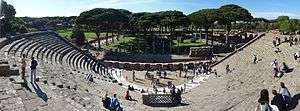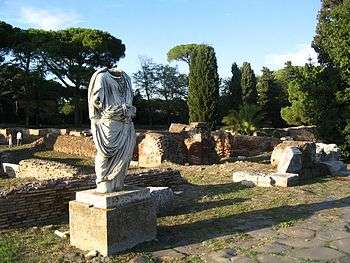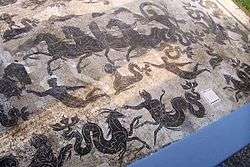Ostia
Ostia is in Lazio, Italy, close to Rome's major airport of Fiumicino. This article covers both the archaeological site Ostia Antica at the south-western end of Rome's district with the same name, and the nearby beach area Lido di Ostia (or simply Ostia).

Understand
Not far from the center of Rome is Ostia Antica, an archaeological site that contains many Roman ruins, dating back to the days when it served as Rome's port (a function now taken over by Civitavecchia). In antiquity is was situated at the mouth of the river Tiber, however the shoreline moved seawards, due to silting, from the Middle Ages until the 19th century. Ostia Antica is today still lying next to the Tiber, but at a distance of some three kilometers from the beach. It is one of Lazio's major attractions, less crowded and, for some, more enjoyable than the ruins of Pompeii. So if you can't make it down to Pompeii don't worry. Just head out to Ostia Antica.
Nearby Lido di Ostia is a residential area, the capital's beach, and a well-known "Tourist Port" with moorings for boats from 8 to 60 metres in length. Italy might be a Catholic country, but you won't detect any religious conservatism in the skimpy bikinis on display here. There's a carnival atmosphere, with dance halls, cinemas, and pizzerias. The Lido is set off best at Castelfusano, against a backdrop of pinewoods, which provide the summer residence of the President of Italy. This stretch of shoreline is referred to as the Roman Riviera.
If you're flying out of Fiumicino, this town is a good stopover for the night before. You can return your rental car if need be, catch a cab for a few-minute, few-kilometer ride to the airport, and forget about the trains and the traffic from Rome.
Get in
By train
If you want to see both ancient and modern Rome, grab your swimsuit, towel, and sunblock, and take the Roma-Lido urban railway (operated by ATAC) from the Roma Porta San Paolo station (see Rome/Aventino-Testaccio). It is directly next to the line B (blue line) metro station Piramide, and within walking distance (500m) of the Roma Ostiense train station. All ATAC tickets and passes for Rome are valid on this urban railway. Departures are about every 15 minutes, or during Sunday and public holidays every 30 minutes; the whole trip takes about 40 minutes. The train lets you off at the Ostia Antica station across one of the highways that connects Rome with the coast. It's just a short walk to the Ostia Antica excavations. Later, board the train again to visit Lido di Ostia and the beach.
By bus
There is also a bus, number 070 departing from EUR Fermi (metro B) and going to the Castelporziano beach.
From the Fiumicino Airport there is a regional bus (COTRAL) departing from Terminal 2 heading to Ostia central station every 40 minutes; the trip takes about a half hour.
Get around
Beaches at Ostia are crowded during the summer months and are full of deck chairs and sunbeds that you have to rent. If you would like a bit more space and a chance to sit on the sand without paying for the privilege you can take a bus from the Cristoforo Colombo train station or hire a bike with specialized company for make a tour around this area. This heads south towards Torvaianica. After a couple of miles of beach and dunes that are closed to the public you come to public beach areas, the dunes of Castelporziano, These have good restaurants, toilets and showers and all the area is a natural reserve and the biggest pinewood in Rome (if you get lost ask for "Cancelli" everybody knows this area as this name)
See
Ostia Antica

🌍 Ostia Antica (Parco Archeologico di Ostia Antica) (Arriving from Rome, get off at Ostia Antica station, a couple of miles from the beach area). From 08:30. Closing time varies according to the season. Closed Mondays. Admission €8 (€4 for EU residents between 18 and 25), maps €2.
Originally a colony of Rome, Ostia grew to become the major port of the city. It was situated on the mouth of the Tiber, the word Ostia meaning "mouth". The town's growth started in the late Republic, but expanded rapidly under the Emperors Claudius and Trajan. The town was deserted after Rome's fall in 476 AD, and the buildings fell into ruins which were in turn covered by sand and mud from the Tiber, preserving them. The ancient town remained farmland until excavations took place in the late 19th and early 20th centuries, and now most of the old town is uncovered, giving the visitor an idea of what life was like in an Ancient Roman commercial town during the height of the Empire. The ruins are similar to those in Pompeii, but there are no wealthy houses in Ostia. The archaeological site is vast, with plenty to see to occupy a full day. You will need to wear good footwear.
In Ostia Antica, you should buy a guide book from the ticket office when you enter. Without a guide book, you will see lumps of stone everywhere. With a guide book, you will understand what buildings stood where those lumps of stone now lie. On your tour look out for:

- The Forum, with its Capitol. The Temple's podium is still in place, as are the walls of the cellar where the cult statues were kept. You get an appreciation of how huge Roman temples were.
- The Piazza of the Corporations, behind the theatre, preserves the offices of trade guilds or merchants from various parts of the world, each office identified by its mosaic floor.
- Ostia is famous for the ancient apartment buildings that are very well preserved. The town's population were poor dock workers living in large apartment buildings. These buildings can be explored to one storey in height, with narrow stairways and corridors leading to small rooms. There are also the remains of more wealthy houses, such as the House of Cupid and Pysche, with very rich marble decorations. You get a real feel for how these people lived 2,000 years ago.
- The small museum contains the main finds from the excavations, ranging from cult statues to small bits of sculpture.
- The ancient warehouses and docks. These are well preserved and look very much like those of the 19th century. The ancient kerbs and pavement are still in place as they are in Pompeii and Herculaneum.
- Visit the two Baths with their beautiful and famous mosaic floors.
Other attractions
- 🌍 Ostia Castle. This is close to Ostia Antica, on the other side of the railway line and Via del Mare in the small village of Ostia Antica. It was built in 1483 by Giuliano della Rovere, who later became Pope Julius II. Much of the building material consisted of bricks pilfered from Ostia Antica.
- 🌍 Pinewood of Castelfusano. Easily accessible from the stations of Cristoforo Colombo or Castelfusano, and the suburb of Infernetto.
- 🌍 Portus. Although Rome's original harbour was at Ostia Antica, but in the Imperial period two harbour basins were added to the north. Around AD 46 the Emperor Claudius constructed a new harbour with two long curving moles projecting into the sea. The harbour opened directly to the sea to the north-west protecting it from the prevailing south-west wind. It connected with the River Tiber by a channel on the south-east. The harbour was known as Portus (Latin for "harbour") and the Via Portuensis still connects Rome with the area. In 103 AD Trajan constructed another harbour farther inland, a hexagonal basin. The basin itself is now a reedy lagoon and remains of the many warehouses can still be seen. Like many points of archaeological interest in the area the port is unfortunately not open to the public without making an appointment. Details at .
Do
- 🌍 Porto turistico di Ostia (About 2km north-west of the center of Ostia). This is a modern development and has berths for up to 794 boats, from 8m to 53m in length. Shops catering to yachties, restaurants and bars. A popular place among Romans for a weekend stroll.
Buy
Eat
- Ostia Antica. There is a modern, clean restaurant inside the site, next to the gift shop which stocks all kinds of items such as postcards, posters, books and souvenirs.
- 🌍 Ferrara (just off the Lungomare near the pier). You know it's terrific because of the crowds all the time. They have all kinds of pizze and many side dishes, all cafeteria style at very reasonable prices, and very tasty.
- 🌍 Gelateria Salus, Lungomare Paolo Toscanelli 117, ☎ +39 06 976 13 117. Very good ice cream (only at the table) in a particularly nice environment, prices are mid-range, but the ice cream and service are worth the price.
- 🌍 Ristorante Don Pepe, Lungomare Paolo Toscanelli 125, ☎ +39 065672408. Italian and Spanish cooking: fish and meat.
- Ristorante-Pizzeria Blue Fin, Lungomare Paolo Toscanelli 120.
- Zenzero Biorestaurant, Viale della Pineta di Ostia 30, ☎ +39 06 562 12 93, e-mail: info@ristozenzero.it. Serves vegetarian food and fish. Very tasty food combined with a nice atmosphere.
Drink
- Faber Beach, Lungomare Paolo Toscanelli 199. Bar and restaurant right on the beach. In winter becomes the Evolution restaurant.
Sleep
- 🌍 Hotel Ping-Pong, Lungomare Paolo Toscanelli 84 (just down from the pier), ☎ +39 065601733. Convenient, reasonable, friendly staff. Fax number is same phone number
- 🌍 Litus Roma Hostel, Lungomare Toscanelli 186. The first hostel by the sea in Rome. Located near the new port of Rome and close to the excavations of Ostia Antica. It's easily reachable from the center of Rome by public transportation. Over 140 beds in comfortable rooms with ensuite bathrooms, TV, sea views, free daily maid service, and laundry services. € 24-38.
Go next
| Routes through Ostia |
| END ← | SW |
→ South → Aventino-Testaccio |